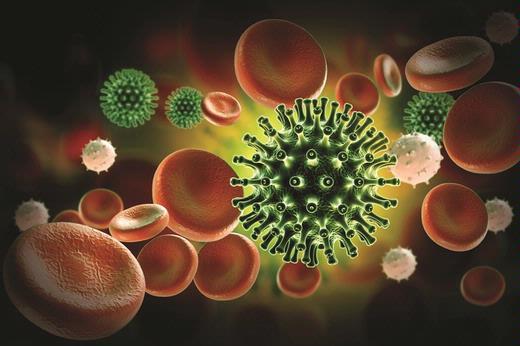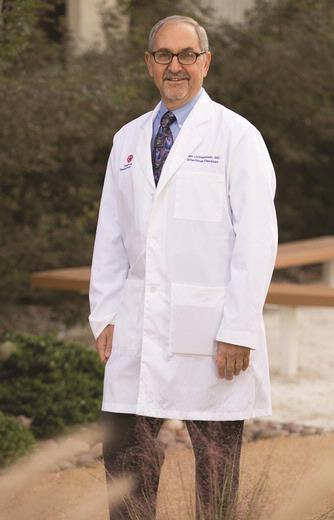Advancing HIV Research and Treatment

“The advances I’ve seen since this disease entered our awareness thirty-plus years ago are mindboggling,” says the nationally recognized clinician and scientist. “In the beginning, we had no idea what we were dealing with or how to manage it, and all we could do was help patients die with dignity.
“In the early days of treatment, we had AZT [azidothymidine, an antiretroviral drug] and other single-drug regimens,” he recalls. “These slowed the progression of the disease somewhat, but patients still died.
“Then, in 1996, drug cocktails were introduced — combinations of multiple drugs in different classes with different mechanisms of action,” he continues. “AIDS researcher David Ho, MD, published the first scientific article on what has become known as HAART — highly active antiretroviral therapy — and was named TIME’s Man of the Year for his work.
“Thanks to HAART, we finally began to see things turn around,” he says. “Rather than watch T-cells fall and viral loads go up, we were seeing viral loads suppressed and T-cell counts returning. And people were feeling better.”
T-cells are a type of white blood cell that plays an essential role in protecting the body from infection. HIV gradually destroys the immune system by attacking T-cells, using them to multiply and spread the virus throughout the body.

While HAART isn’t a cure, it slows the rate at which HIV multiplies, and reduces the viral load to virtually undetectable levels — transforming HIV from what used to be an all-but-certain death sentence to what is now a largely manageable chronic condition.
The “graying” of HIV disease
“As a result, HIV-positive patients who survived until HAART became available and got into treatment were able to maintain or regain their health,” says Dr. Lichtenstein. “A lot of the population in Palm Springs is made up of these individuals who got their lives back, have since retired and moved to the desert.
“In fact, thirty percent of our HIV/AIDS patients are over age 65,” he notes, while that figure is only seven percent among HIV-infected individuals nationwide, according to the U.S. Centers for Disease Control and Prevention (CDC).
This “graying” of HIV disease is one of medicine’s greatest success stories, but it also has created a new challenge.
While older patients with HIV develop the same diseases associated with aging as the rest of the population — conditions such as coronary artery disease, high blood pressure, heart disease, arthritis and diabetes — it now appears that they are developing them at higher rates than people who aren’t HIV-positive.
“The incidence of these ‘diseases of aging’ is 1.5 to 2.5 times higher in HIV-infected people than in non-infected people of the same age,” Dr. Lichtenstein explains. “When we look for a common denominator, it appears to be chronic inflammation, which we know is a contributing factor in many of these diseases.”
A major federally funded study
Eisenhower Medical Center is helping to address this medical issue by participating in a major federal study sponsored by the National Institutes of Health’s Division of AIDS and its AIDS Clinical Trial Group.
“This study is looking at cardiovascular disease in HIV-positive patients, and whether we can reduce someone’s risk of experiencing a heart attack or stroke, or suffering the after-effects of such a devastating event, by giving them a statin drug sooner than currently recommended by national guidelines,” says Eisenhower’s Director of Research Administration Stephanie Farrell, MBA, RN, BSN, CCRC, CPHQ.
Statins are a class of drugs prescribed to help lower cholesterol levels in the blood, which can help prevent heart attacks and stroke. Studies show that statins can reduce the risk of heart attack, stroke and even death from heart disease by 25 to 35 percent. Research also shows that statins can reduce inflammation in arterial walls.
“By the nature of the disease, people with HIV have higher rates of inflammation because their immune system is constantly fighting the virus, putting them at higher risk of comorbidities like cardiovascular disease,” Farrell notes.
“There also is data showing that adipose (fat) tissue is an inflammatory organ,” Dr. Lichtenstein says. “The more fat in the body of someone who’s HIV-positive, the more activation of T-cells and replication of the virus. So being obese isn’t only a bad thing for the general population, it’s extra bad in the HIV population.”
“Which makes the standard advice to exercise, maintain a healthy body mass index, and eat a well-balanced diet even more important for someone with HIV,” Farrell adds.
Other HIV research at Eisenhower
Under Dr. Lichtenstein’s leadership, Eisenhower is involved in other HIV research as well.
“We not only partner with the National Institutes of Health but also with industry to bring clinical trials and promising new treatments to the community setting,” Farrell says.
Notably, the GSK (GlaxoSmithKline) ATLAS study is looking at the efficacy of a long-acting two-drug injectable regimen that may offer an alternative to daily oral drug therapy in HIV-positive people. The two drugs are an FDA-approved antiviral (rilpivirine) and an investigational integrase inhibitor (integrase inhibitors are drugs that prevent HIV genetic code from integrating with human DNA).
“While we have great oral drugs to keep the virus in check, if patients aren’t compliant, it can give the virus the edge,” Farrell notes.
“A monthly injection could do wonders for compliance,” Dr. Lichtenstein adds. At this writing, the GSK-ATLAS study is slated to begin enrolling participants at the end of 2016. If you or someone you know is interested in being considered for participation, please contact the research office at 760-834-7049 or research@emc.org.
A clinical trial already underway is sponsored by drug manufacturer Gilead; it’s looking at another new integrase inhibitor, combined with other medications in a single daily pill, to determine how it performs compared to current standard therapy.
In addition, Eisenhower is part of a newly formed collaborative of all the HIVtreating institutions in the Coachella Valley.
“We’re working together to set up a cooperative environment so if one institution has a patient who’s a candidate for a study at another institution, we can more easily make it available,” Dr. Lichtenstein says. “We want to not only enhance the research capabilities here in the valley but also increase people’s access to these resources.”
“Every single lifesaving treatment available today is a direct result of an HIV-positive person being willing to participate in a clinical trial and make a difference,” Farrell adds. “Research truly is a partnership between the community and the scientists working to keep advancing on this disease and, hopefully, one day eliminate it.”
An emphasis on prevention
While HIV research holds promise for the future, Eisenhower is equally committed to providing the best possible treatments and education on preventive strategies in the here and now.
An important initiative in this arena is TRUVADA® for PrEP (pre-exposure prophylaxis). TRUVADA is a prescription medicine that can reduce the risk of getting HIV when taken daily and used together with safer sex practices, which includes the correct use of condoms during any kind of sex.
TRUVADA for PrEP is only for HIVnegative adults who are at high risk of getting HIV through sex. This includes HIV-negative men who have sex with men, and male-female sex partners in which one partner has the HIV infection and the other does not.
“Studies have shown up to a 97 percent reduction in HIV transmission when HIV-negative folks adhere to the PrEP regimen,” Dr. Lichtenstein says. “But it requires taking the TRUVADA pill daily, getting tested every three months, and undergoing counseling about condom use. When people are distracted by their busy lives, compliance can be an issue.”
To address this, Eisenhower is setting up a registry with a clinical coordinator who will maintain contact with and monitor all patients to ensure they’re following the PrEP guidelines.
“We want to achieve a 100 percent prevention rate, as in failure to transmit the disease,” he adds. “We’re hopeful that this careful one-to-one management to ensure compliance will produce this type of outcome.”
By studying how patients do as a result of the care they receive — whether in formal clinical trials or in everyday clinical practice — Eisenhower can identify and adopt the best practices for optimal patient outcomes.
“It would be wonderful to develop a vaccine and do away with HIV like we did with smallpox,” Dr. Lichtenstein says. “But this virus is always mutating, and finding a stable portion to which to direct a vaccine continues to be problematic. I think a vaccine is at least ten years away.
“That’s why our emphasis needs to remain on prevention, particularly the PrEP treatment as prevention, and condom use,” he continues, “and we must continue to educate the community.
“I’m also a big proponent of universal screening for HIV and hepatitis C (HCV),” he adds, referring to a form of viral hepatitis transmitted in infected blood, causing chronic liver disease.
“Today there are over a million people in the United States living with HIV, and between three and five million people with HCV, but most don’t know they have hepatitis C,” Dr. Lichtenstein says.
“With screening, however, we can identify these infections and get people into treatment,” he notes. “We not only have good treatments to suppress HIV, but we also have incredible treatments to cure hepatitis C in as few as 12 weeks.”
To learn more about Eisenhower’s services, visit emc.org/LGBT.